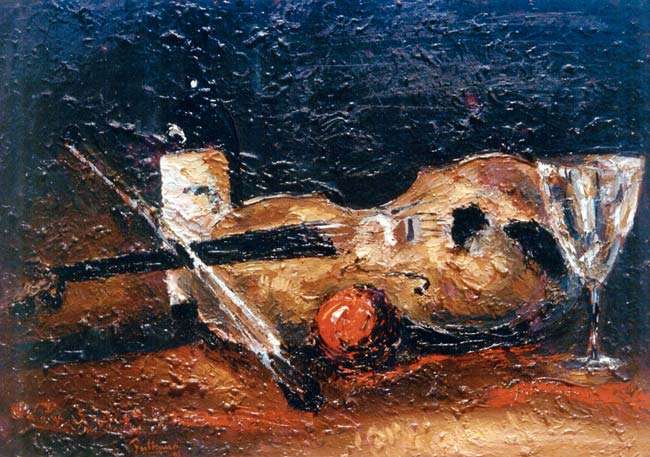Fernando Monteiro
The Act of Looking
Painting is its own theme - here, without words, Plínio Palhano claims, more than ever, in these paintings what he has always been claiming ("in painting, only matter") through his work, in a similar way, but with less obsession, less acuteness than in his former exhibitions.
Palhano is the same, now and yesterday, however this time he publicly and openly undertakes a responsibility with the palette - to put it in an old-fashioned way - in a passion-ridden and outspoken manner, not to say radical, in a seeming "pullback" or backward move to his traditional subject-matters (still lives, nudes) here intensified, maybe surprising his generation colleagues, even though to many it may look like a kind of pictorial "domestication." But it will be a mistake, if not an interested depreciation, to confound the passion set out fair and square and try to ignore that the compulsion of these paintings is strong for a tradition resumed by the opposite of inertia.
On the contrary, moving from itself to itself in the field of the "cosa mentale", musing on the silence among the objects, the Borgean language of the mirrors and the body which never quits being a discovery, shows, in this case, that an artist definitively grows ripe to his technique and finally feels himself able to move at ease between modernity and tradition.
The great pleasure of painting…is to paint, says Plínio, fair and square again, in the manifestation of silence of these traditional motifs he disturbs with reds, displaces, here and there, with his flowers of fire and rearranges on the same common table of art or on the same bed not yet completely abandoned by the "maja".
The reference made to Goya´s muse came in time to bring to mind the Spaniards, the Tenebrists, the Flemings who Plínio indirectly quotes and pays homage without giving himself up, for his painting (like that of no one else) has not come from scratch, from the vacuum where the shapes are still waiting for the artist´s creative act. This display, on the other hand, gives a small lesson in modesty and belief in the non-exhaustion of the motifs, tries to recover the craft humbly in front of the objects and themes, and seeks to restore the faith in the painting with an almost unsettling courage, at least in our milieu where the vanguard of the 70s (now older than the Academicism) is still coming in parts and badly digested, with a few exceptions. Returning to the point, Plínio Palhano, first, re-feeds the pleasure of his craft, second, rediscovers the subject-matter and then connects his work to the tradition of masters like the seminal and praised Velásquez - or the "sideliner" (and not less fêted) Jean Baptist Carpeaux, French painter (1827-1875) whose mastery was unrighteously relegated to the small rooms of Louvre, despite his excellent technique and brilliant formal resolution, nervous and filled with light brushstrokes which have always reminded me of Plínio´s (so far from Carpeaux, in space and time). But, I believe, art is a great complicity, in the most dignified sense of the word, and it is out of virtue, almost magical, of its outstanding strain that, here, in the catalogue of the new exhibition of an artist who was born almost one hundred and thirty years later, a forgotten master deserves an unexpected remembrance… on the majestic circular river of the painting that Plínio confirms as a matter of itself - in fact, atemporal and contemporary of all its ages, in such a way that the painters of the Pompeian red, even unknown, are also back in Plínio´s attraction for this difficult color which, in him, immediately gains a Munchean stress, mark of the modernity that the artist does not ignore as he keeps on trying to add his particular vision to the resistant "métier" of the painting at the turn of this century and millennium which makes us, as in every turn of time´s screw, contemporary of all.
This contemporaneousness, inseparable from the Relativism, Plínio Palhano, with a mature peacefulness, takes on the simplicity of the (truly) complex persons and the certainty of those who know to paint - and to paint mainly their doubts in front of the ambiguous materiality of things and bodies in the undulatory world of light in particles.
In front of it, the painter asks himself - like the Spaniards in the golden century asked themselves as to the official mission of the picture, or as the modest Carpeaux asked himself in the lights of a ball in the Tuileries - proposing to recreate a still life with violins and northeastern cashews after another with fruits, in a way, more "classical", the same way two naked bodies, in this room of the Ranulpho Gallery, now deny themselves as real, now affirm themselves in burned interiors.
However, in all of these works, objects and shapes communicate themselves through their sheer existence in the light - which is the phenomenal key to the paintings - and they turn out to be eighteen mute witnesses, unable to talk the silent "talk" of Plínio, as well as the timeless language of an ageless painting.
Back to THE ACT OF LOOKING




